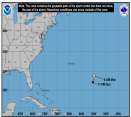Jamiewx -- that's pretty much the same track as the NHC. I'd imagine it's probably the same forecast, as deviations from the official path without clearly noting that they are not the official track forecast issuers are frowned upon.
With Ivan -- I've looked at a few more things here, and here's what I think as of now. Frances steering away will help to draw Ivan ever so slightly northward, probably in 12-24hr, as will a slight weakness in the ridge to it's north. The ridge to it's north is consolidating near Bermuda as opposed to further south, which in itself should allow a bit more northward motion. The trough currently entering the west has a punch to it, but it's awfully far to the north and I don't see it being able to punch downward far enough to completely turn the storm. The current flow pattern favors a gradual movement towards the southeast/south central Gulf, followed by some more movement northward, and I don't really see much to change this drastically.
Ivan should end up crossing extreme western Cuba in about 4 days, possibly also crossing the Isle of Youth. I think it just might miss Jamaica to the south. Projected time frame from the NHC looks good; if anything, I'd bump up the times a few hours, but that's not of much concern right now. It's too early to narrow a landfall point down, but I'd place highest odds on the region between Apalachicola and Biloxi, with slightly lower odds from Apalachicola eastward to Ft. Myers. I don't see this missing the coast and the Gulf. Those in the western Gulf should pay heed to this as well -- the longer this goes west, the more the danger to them increases.
Intensity -- with the current environment, strong outflow and an upper-low to the west to exhaust the storm, I don't see any reason why some further strengthening is not possible. I think most of it will occur as we get a bit closer to Jamaica and that intensity fluctuations will primarily be controlled by eyewall replacement cycles, but low-end 5 is not out of the realm of possibility. I mentioned this possibility awhile back on the temp board and still believe in it, albeit we're much further to the west now. I think Ivan is probably close to peaking for the time being, followed by some slight weakening (which may or may not end up reflected in the actual intensity products from the NHC), then perhaps another rampup after the next eyewall replacement cycle.
Of note is that the stronger the storm gets, the natural tendency is for the storm to gradually gain latitude. There exists a balance between the pressure gradient force, or how strong the difference is between a high and a low, and the coriolis force, which is the atmosphere's contribution to the spin of a storm. If the storm gets stronger, the pressure gradient force goes up as the pressure gradient tightens. As such, the Coriolis must increase, which leads to the storm to drift a bit further north.
Bottom line -- be prepared for anything.
--------------------
Current Tropical Model Output Plots
(or view them on the main page for any active Atlantic storms!)
|




 Flat
Flat



